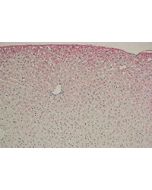Cookie Policy: This site uses cookies to improve your experience. You can find out more about our use of cookies in our Privacy Policy. By continuing to browse this site you agree to our use of cookies.
JaICA
anti-Hexanoyl-Lys [HEL], mAb (5F12)

| Product Details | |
|---|---|
| Product Type | Monoclonal Antibody |
| Properties | |
| Clone | 5F12 |
| Isotype | Mouse IgG1κ |
| Immunogen/Antigen | N epsilon hexanoyl-keyhole limpet hemocyanin (HEL-KLH). |
| Application |
ELISA |
| Crossreactivity |
All Human |
| Specificity |
Recognizes Hexanoyl-Lys adducts. Does not cross-react with MDA, glyoxal, methylglyoxal, 1-hexanal, 2-hexenal, 1-nonannal, 2-nonenal, 4-hudroxy-2-nonenal. |
| Formulation | Lyophilized. Contains 10mM PBS (pH7.4), 5% sucrose, 1% BSA and 0.05% Procline 950. |
| Reconstitution | Reconstitute with 200μL distilled water. |
| Isotype Negative Control | |
| Other Product Data |
Click here for Original Manufacturer Product Datasheet |
| Declaration | Manufactured by JaICA. |
| Shipping and Handling | |
| Shipping | BLUE ICE |
| Short Term Storage | +4°C |
| Long Term Storage | -20°C |
| Handling Advice | Avoid freeze/thaw cycles. |
| Use/Stability |
Stable for at least 3 years after receipt when stored at -20°C. After reconstitution, prepare aliquots and store at -20°C. |
| Documents | |
| Protocols |
 Download PDF Download PDF |
| Product Specification Sheet | |
| Datasheet |
 Download PDF Download PDF |
Oxidative damage to lipids (lipid peroxidation) has been found to play an important role in various disease and aging processes. During early stages of lipid peroxidation, lipid hydroperoxides (LOOH) are formed. These can react additionally to form later stage end products such as malondialdehyde (MDA) and hydroxynonenal (HNE). LOOH is measured to quantify early stage or acute lipid peroxidation while MDA is commonly measured to quantify late stage or chronic lipid peroxidation. More recently, it has been reported that 13-hydroperoxyoctadecanoic acid (13-HPODE), a precursor to 13-hydroxyoctadecanoic acid (13-HODE) can react with proteins to form measurable adducts by covalently binding to specific amino acid residues. The Hexanoyl-Lysine (HEL) adduct is formed upon oxidative modification of omega-6 fatty acids such as linoleic acid, the predominant polyunsaturated fatty acid (PUFA) in the human diet, and arachidonic acid. HEL may be another useful biomarker for detecting and quantifying the earlier stages of lipid peroxidation.
- Preparation of a monoclonal antibody to N(epsilon)-(Hexanonyl)lysine: application to the evaluation of protective effects of flavonoid supplementation against exercise-induced oxidative stress in rat skeletal muscle: Y. Kato, et al.; BBRC 274, 389 (2000) [Development and characterization of anti-HEL monoclonal antibody]
- Immunohistochemical detection of oxidative stress biomarkers, dityrosine and N(epsilon)-(hexanoyl)lysine, and C-reactive protein in rabbit atherosclerotic lesions: Y. Fukuchi, et al.; J. Atheroscler. Thromb. 15, 185 (2008) [Application to rabbit atherosclerotic lesions]
- A water-soluble fullerene vesicle alleviates angiotensin II-induced oxidative stress in human umbilical venous endothelial cells: R. Maeda, et al.; Hypertens. Res. 31, 141 (2008) [Application to cultured cells (HUVECs)]
- Differential Effects of High Glucose and Methylglyoxal on Viability and Polyol Metabolism in Immortalized Adult Mouse Schwann Cells: K. Sango, et al.; Open Diabetes J. 1, 1 (2008) [Application to cultured cell from mouse]






![anti-4-Hydroxy-2-hexenal [4-HHE], mAb (HHE53)](https://update.adipogen.com/media/catalog/product/placeholder/default/adipogen_logo_bw_3.png)
